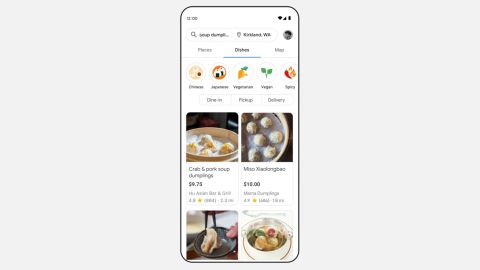
CNN Business
—
Google is making it easier to find specific dishes at nearby restaurants, whether it’s an ahi tartare, soup dumplings, or something else entirely.
A new search feature the company announced Wednesday will let users search for a particular dish by typing its name and “near me” to see a list of results with images showing where it’s available nearby. You’ll also be able to click on each image to see details about the price, ingredients, and restaurant. The feature will also let users search for versions of dishes that are vegan, vegetarian, or spicy. Google
(GOOG) plans to roll out the feature via the Google
(GOOG) app and its mobile search website in the coming months, initially only in English and in the United States.
Google introduced the feature during an online event where it showed off updates to its search and mapping products. The updates are meant to build on the company’s longstanding goal of making it possible to search for all kinds of things in many ways, whether that’s by typing a question into a search box, taking a photo of a purple dress and typing “green” to indicate you want to find it in a verdant hue, or humming an unknown tune into your phone to figure out what it is.

In an interview with CNN Business, Sophia Lin, Google’s general manager for food experiences on search, pointed to soup dumplings (a food that, for her family is “one of the ways we bond”) as an example of an item that the dish-specific search feature will make easier to track down.
You can currently use Google to look for dishes at nearby restaurants, but the results can be hit or miss. For instance, when I searched early this week for “soup dumplings near me,” the top results included several restaurants that had soup and/or dumplings, but not soup dumplings.
That’s because the search engine currently plops you into a list of restaurants it thinks are related to any dish-specific queries. Sometimes, a restaurant listing will include the dish you’re looking for; sometimes it won’t. And even if you do find evidence of the item you want, such as in a user review surfaced along with the restaurant listing, you might not get much detail beyond its availability.
To make the new feature accurate, Lin said Google is drawing on data from sources including reviews, photos, and videos submitted by users to Google Maps, from details that restaurants use to do things like update their menu information, and from some restaurant websites. The company uses artificial intelligence tools to help it sort through the information, doing things like highlighting dishes that are likely to be vegan or vegetarian. AI also helps match dish photos with written menu items, which can be particularly tricky for a computer when it comes to a picture of a food like soup dumplings, as different types of dumplings often look the same on the outside.
“The problem we’re really trying to solve with this feature is, ‘How do we tackle head-on that problem of you’re just digging through endless menus trying to find the thing you want to eat?’ And making it way easier for people to get directly to the dish they’re looking for,” Lin said.
